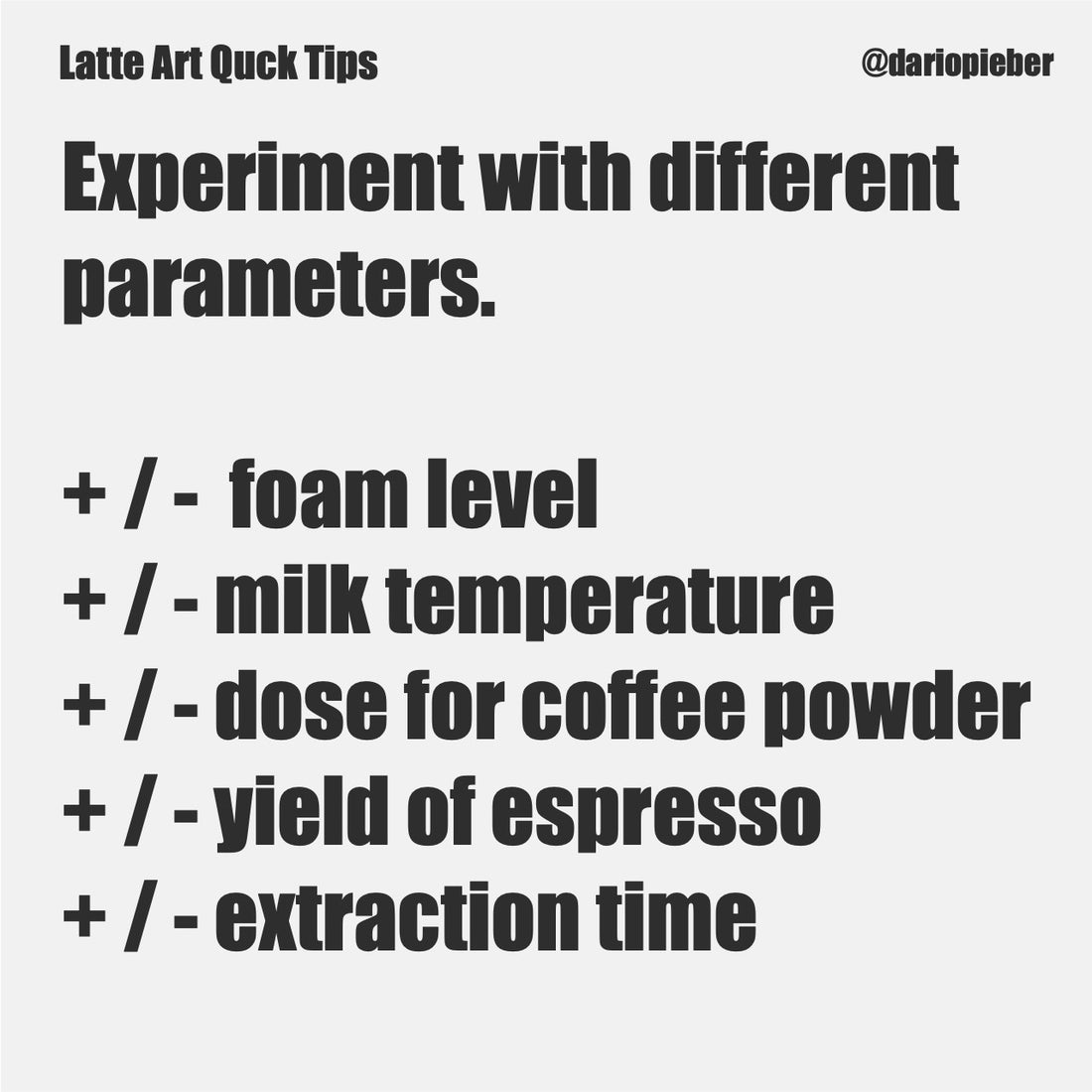
Latte Art Quick Tips #001
Share
Latte art is not just about aesthetics; it's about achieving the perfect balance between taste, texture, and visual appeal. Whether you're a barista-in-training or a seasoned coffee enthusiast, experimenting with different parameters is key to mastering the art. Let’s dive into some crucial elements you can tweak to create a latte that looks as good as it tastes.
1. The Foam Level: Thicker or Thinner Milk Foam?
The amount of milk foam in your latte significantly impacts both its texture and flavor. When it comes to latte art, we're always working with thinner milk foam to create intricate designs. In a finished latte or cappuccino, the ideal foam level typically ranges from 0.5 cm to 2 cm. Even within this narrow range, there's a substantial difference in how your latte art will turn out.
Experimenting with Foam Levels for Different Latte Art Patterns
Try pouring the same latte art pattern with varying foam levels. You'll quickly notice which foam consistency works best for different designs. For traditional latte art patterns like winged tulips or rosettas, a thinner milk foam is ideal. This is because you want the milk to glide effortlessly onto the coffee surface. These patterns are primarily created through the milk flow, so a thinner foam helps achieve the desired effect.
For modern latte art designs such as seahorses or lions, a higher foam level is essential. These patterns require a lot of milk flow for the initial elements, while the final details demand a thicker, "dry" foam. Each latte art pattern has its own optimal foam level, which allows the milk to pour perfectly and achieve the best visual results.
By understanding the role of milk foam in latte art, you can create beautiful and delicious coffee drinks that stand out. Experiment with different foam levels to discover which works best for your preferred latte art style, whether traditional or modern.
2. Temperature Matters: Playing with Milk Temperature
Milk temperature is a critical factor in creating perfect latte art, but it can be tricky to get just right. If you live in a region with colder seasons, consider heating the milk a bit hotter to keep your customers satisfied. During the warmer months, you have more flexibility to experiment with different temperatures. However, the ideal milk temperature is closely tied to the type of coffee beans you use, and it directly affects the crispness and clarity of your latte art.
Finding the Optimal Milk Temperature for Latte Art
In most barista classes, you're taught to steam milk to a range of 50-65°C (122-149°F). While this is a good starting point, it's quite a broad range, and finding the right temperature within this window can make a big difference.
For traditional latte art, such as tulips or rosettas, milk temperature is less critical. As long as you stay within the optimal range of 50-65°C, you should achieve good results. The temperature mainly affects the texture of the milk, and as long as it’s steamed correctly, you’re likely to create clean and beautiful patterns.
However, for modern latte art designs, getting the milk temperature just right can be more challenging. When creating intricate designs, especially those involving "dry foam" for the final elements of the pour, you might notice some blurring or loss of definition. One simple solution is to froth the milk only up to 45-50°C (113-122°F). This lower temperature often works wonders, providing a smoother, more consistent texture for complex designs.
Keep in mind, though, that some customers prefer their latte or flat white served hotter. This lower temperature method might be best suited for latte art competitions or when making coffee for yourself.
Understanding how milk temperature affects your latte art allows you to cater to your customers' preferences while perfecting your craft. Experiment with different temperatures and find the sweet spot that complements both your beans and your artistic style.
3. Adjusting the Coffee Dose: More or Less?
The amount of coffee grounds you use can significantly impact the strength and flavor profile of your latte. However, let's focus specifically on how the coffee dose affects your latte art.
Understanding Crema and Its Impact on Latte Art
When using a higher coffee dose, you'll likely end up with more crema in your espresso. Crema can be either your best friend or your worst enemy, depending on the latte art style and the roast level you're working with.
For traditional latte art like hearts, tulips, or rosettas, I generally use a slightly higher coffee dose when working with medium to dark roasts. The thick, rich crema provides excellent contrast against the milk, helping to create designs that are both sharp and well-defined. On the other hand, a lower coffee dose can result in pours that lack clarity and definition. The same principle applies to lighter roasts, but be aware that lighter roasts typically produce less crema, which can result in less contrast for your latte art, even though the coffee may taste great!
Coffee Dose for Modern Latte Art
When it comes to modern latte art designs, both higher and lower coffee doses can work, but the choice depends on the specific roast and the style you're aiming for. A darker roast with a higher dosing recipe may yield a rigid, dry crema. While this can make the initial pours easier, it often results in poor contrast and blurriness, especially for the final elements involving dry foam. A lower dose recipe, however, tends to produce a cleaner, smoother crema that enhances contrast and clarity, regardless of whether you're using a darker or lighter roast.
Keep in mind that achieving the perfect balance for modern latte art requires focused practice, as different coffee beans will behave uniquely. Experimenting with both high and low doses across various roasts will help you discover what works best for your preferred style.
By understanding how coffee dose impacts your latte art, you can create visually stunning designs that also taste exceptional. Practice and experimentation are key, so don’t be afraid to tweak your coffee dose and see what new patterns emerge!
4. Finding the Perfect Yield: More or Less Coffee?
When it comes to creating beautiful latte art, the espresso yield—the volume of espresso extracted from the coffee grounds—plays a crucial role. While yield primarily affects the coffee's taste, it also significantly influences how your latte art turns out.
Using a Higher Yield for Latte Art
A higher yield means more water is used to extract the coffee, diluting the concentration and spreading the coffee’s flavor profile more evenly. This is particularly useful when working with light roasts. Light roasts often have a higher acidity, which can make latte art appear blurry if the acidity is too concentrated. By using a higher yield, you can spread out that acidity and create cleaner, more defined pours. For light roasts, a slightly higher yield often results in better contrast and sharper latte art designs.
Using a Lower Yield for Latte Art
On the other hand, a lower yield packs all the coffee's flavors tightly together, creating a more intense and concentrated shot. This method is particularly effective with darker roasts, which tend to produce a thicker, more rigid crema. A lower yield helps to retain that rich, dense crema, providing a stable base for your latte art and enhancing contrast for visually striking patterns.
Choosing the Right Yield for Your Latte Art Style
Understanding how yield affects your latte art can help you achieve the best results, whether you're working with light or dark roasts. Experiment with both higher and lower yields to see how they influence the crema, contrast, and clarity of your designs. Adjusting your yield based on the roast type can take your latte art to the next level.
5. Timing is Everything: More or Less Extraction Time?
The extraction time of your espresso plays a vital role in determining how much of the coffee’s flavor and aroma compounds are released. While this primarily affects the taste, it also has a significant impact on your latte art.
Shorter Extraction Time for Latte Art
A shorter extraction time results in a less concentrated espresso with a more acidic flavor. This increased acidity can create challenges for your latte art, especially when working with dry foam. The acidity may cause the milk to blur, leading to less defined patterns. If you're aiming for clean, sharp latte art, a shorter extraction time may not always be ideal.
Longer Extraction Time for Latte Art
On the other hand, a longer extraction time produces a stronger, more intense flavor profile with less acidity. While this can result in a richer, smoother espresso, it also tends to create a more rigid crema. While a thicker crema can provide a stable base for some latte art designs, it might work against you for more intricate patterns where a more fluid milk flow is needed.
Choosing the Right Extraction Time for Your Latte Art Style
Ultimately, the best extraction time depends heavily on the latte art style you’re aiming for and the type of coffee you’re using. Experiment with both shorter and longer extraction times to see how they affect your milk pours and crema, and adjust according to the roast and design you want to achieve.
Conclusion
Mastering latte art is about more than just technique—it's about understanding how various factors like milk foam, temperature, coffee dose, yield, and extraction time impact your designs. By experimenting with different parameters, you can find the ideal combination that brings out the best in both your art and your coffee’s flavor.
Whether you’re crafting traditional patterns like tulips and rosettas or attempting more intricate modern designs, adjusting these variables allows you to control contrast, clarity, and texture. Each element, from the amount of milk foam to the extraction time, plays a unique role in shaping the final result.
Remember, every cup of coffee is a canvas, and each pour offers a new opportunity to refine your skills. So don’t be afraid to tweak the variables and discover what works best for you. With practice and a willingness to experiment, you’ll soon be creating stunning latte art that delights both the eyes and the palate.
